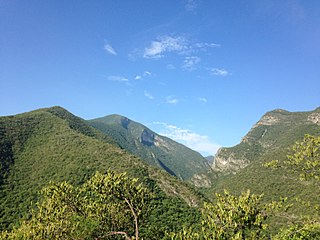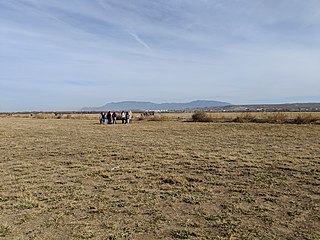
Brownsville is a city in the U.S. state of Texas and the seat of Cameron County, located on the western Gulf Coast in South Texas, adjacent to the border with Matamoros, Tamaulipas, Mexico. The city covers 145.2 sq mi (376.066 km2), and had a population of 186,738 at the 2020 census. As of the 2020 U.S. Census, it is the 139th-largest city in the United States and 18th-largest in Texas. It is part of the Matamoros–Brownsville metropolitan area. The city is known for its year-round subtropical climate, deep-water seaport, and Hispanic culture.

The Chihuahuan Desert is a desert ecoregion designation covering parts of northern Mexico and the southwestern United States. It occupies much of far West Texas, the middle to lower Rio Grande Valley and the lower Pecos Valley in New Mexico, and a portion of southeastern Arizona, as well as the central and northern portions of the Mexican Plateau. It is bordered on the west by the Sonoran Desert, the Colorado Plateau, and the extensive Sierra Madre Occidental range, along with northwestern lowlands of the Sierra Madre Oriental range. Its largest, continual expanse is located in Mexico, covering a large portion of the state of Chihuahua, along with portions of Coahuila, north-eastern Durango, the extreme northern part of Zacatecas, and small western portions of Nuevo León. With an area of about 501,896 km2 (193,783 sq mi), it is the largest hot desert in North America. The desert is fairly young, existing for only 8000 years.

The Lower Rio Grande Valley, commonly known as the Rio Grande Valley or locally as the Valley or RGV, is a region spanning the border of Texas and Mexico located in a floodplain of the Rio Grande near its mouth. The region includes the southernmost tip of South Texas and a portion of northern Tamaulipas, Mexico. It consists of the Brownsville, Harlingen, Weslaco, Pharr, McAllen, Edinburg, Mission, San Juan, and Rio Grande City metropolitan areas in the United States and the Matamoros, Río Bravo, and Reynosa metropolitan areas in Mexico. The area is generally bilingual in English and Spanish, with a fair amount of Spanglish due to the region's diverse history and transborder agglomerations. It is home to some of the poorest cities in the nation, as well as many unincorporated, persistent poverty communities called colonias. A large seasonal influx occurs of "winter Texans" — people who come down from the north for the winter and then return north before summer arrives.

The Mexico–United States border wall is a series of vertical barriers along the Mexico–United States border intended to reduce illegal immigration to the United States from Mexico. The barrier is not a continuous structure but a series of obstructions variously classified as "fences" or "walls".

The Sierra Madre Oriental is a mountain range in northeastern Mexico. The Sierra Madre Oriental is part of the American Cordillera, a chain of mountain ranges (cordillera) that consists of an almost continuous sequence of mountain ranges that form the western "backbone" of North America, Central America, South America, and Antarctica.
Laguna Atascosa National Wildlife Refuge is the largest protected area of natural habitat left in the Lower Rio Grande Valley. The 120,000-acre (49,000 ha) refuge is located almost entirely in Cameron County, Texas, 25 mi (40 km) east of Harlingen, although a very small part of its northernmost point extends into southern Willacy County.

The Mexico–United States border is an international border separating Mexico and the United States, extending from the Pacific Ocean in the west to the Gulf of Mexico in the east. The border traverses a variety of terrains, ranging from urban areas to deserts. The Mexico–U.S. border is the most frequently crossed border in the world with approximately 350 million documented crossings annually. It is the tenth-longest border between two countries in the world.

The Secure Fence Act of 2006, also labelled H.R. 6061, is an act of the United States Congress which authorized and partially funded the construction of 700 miles (1,125 km) of fencing along the Mexican border. The Act was signed into law on October 26, 2006, by U.S. President George W. Bush, who stated at the time that the Act would "help protect the American people", would "make our borders more secure", and was "an important step toward immigration reform".
Santa Ana National Wildlife Refuge is a 2,088-acre (8.45 km2) National Wildlife Refuge situated along the banks of the Rio Grande, south of Alamo in the Lower Rio Grande Valley, in Hidalgo County, South Texas.
The World Birding Center is the official title given to a combined nine parks and nature preserves in the Rio Grande Valley region of Texas managed by a partnership of the Texas Parks and Wildlife Department, the United States Fish and Wildlife Service, and the local communities in which the parks reside. The stated mission of the World Birding Center is to "protect native habitat while increasing the understanding and appreciation of the birds and wildlife", with an additional emphasis on promoting local economic development through ecotourism.

The Tamaulipan mezquital is a deserts and xeric shrublands ecoregion in the Southern United States and northeastern Mexico. It covers an area of 141,500 km2 (54,600 sq mi), encompassing a portion of the Gulf Coastal Plain in southern Texas, northern Tamaulipas, northeastern Coahuila, and part of Nuevo León.

With a total area of 121,590 square miles (314,900 km2), New Mexico is the fifth-largest state, after Alaska, Texas, California, and Montana. Its eastern border lies along 103°W longitude with the state of Oklahoma, and 2.2 miles west of 103°W longitude with Texas. On the southern border, Texas makes up the eastern two-thirds, while the Mexican states of Chihuahua and Sonora make up the western third, with Chihuahua making up about 90% of that. The western border with Arizona runs along the 109° 03'W longitude. The southwestern corner of the state is known as the Bootheel. The 37°N parallel forms the northern boundary with Colorado. The states of New Mexico, Colorado, Arizona, and Utah come together at the Four Corners in New Mexico's northwestern corner. Its surface water area is about 292 square miles (760 km2).

The San Bernardino National Wildlife Refuge is located on the U.S.-Mexico border in Cochise County, Arizona. Situated at 3,720 to 3,920 feet (1,130–1,190 m) elevation in the bottom of a wide valley, the refuge encompasses a portion of the headwaters of the Yaqui River, which drains primarily western Chihuahua and eastern Sonora, Mexico. The 2,309-acre (9.34 km2) ranch was acquired by the U.S. Fish and Wildlife Service in 1982 to protect the water resources and provide habitat for endangered native fishes.

The Lower Rio Grande Valley National Wildlife Refuge is a 90,788-acre (367.41 km2) National Wildlife Refuge located in the Lower Rio Grande Valley region of southern Texas.

Bentsen-Rio Grande Valley State Park is located at 2800 S. Bentsen Palm Drive south of the city of Mission in Hidalgo County in the U.S. state of Texas. It serves as the headquarters for the World Birding Center.

The Valle de Oro National Wildlife Refuge is a protected area in New Mexico managed by the United States Fish and Wildlife Service as part of the National Wildlife Refuge System. It is located 7 miles (11 km) south of Albuquerque, New Mexico. This unit abuts the Rio Grande Valley State Park, which is adjacent to the Rio Grande.

The Trump wall, commonly referred to as "The Wall", is an expansion of the Mexico–United States barrier that started during the U.S. presidency of Donald Trump and was a critical part of Trump's 2016 presidential campaign platform leading up to the year's election. Throughout his campaign, Trump called for the construction of a border wall. He said that, if elected, he would "build the wall and make Mexico pay for it". Then–Mexican president Enrique Peña Nieto rejected Trump's claim that Mexico would pay for the wall; all construction in fact relied exclusively on U.S. funding.

The environmental impacts of the Mexico–United States border are numerous, including the disposal of hazardous waste, increase of air pollution, threats to essential water resources, and ecosystem fragmentation.
Resaca de la Palma State Park is one of three state parks belonging to the World Birding Center and managed by the Texas Parks and Wildlife Department. At 1,200 acres, Resaca de la Palma State Park is the largest of the World Birding Center sites and is located in Brownsville. The property was acquired by the Texas Parks and Wildlife Department in 1977 and was opened to the public in December 2008. A resaca is a type of oxbow lake that can be found in Texas, and is a former channels of the Rio Grande. It is naturally cut off from the river, having no inlet or outlet.

La Lomita Chapel is a historic Catholic chapel in Mission, Texas. It was once an important site for the Cavalry of Christ, a group of priests who traveled long distances on horseback to minister to Catholics living on isolated ranches along the Rio Grande.


















